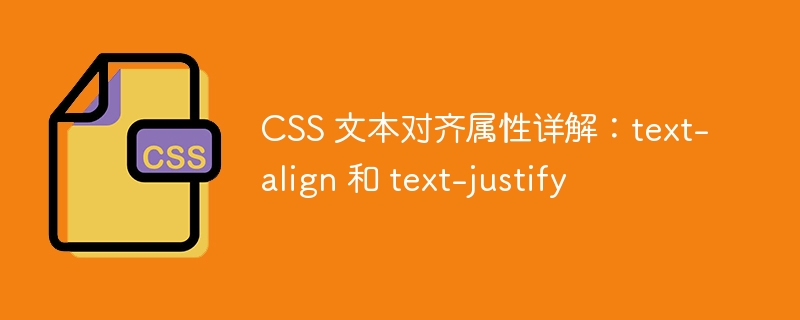

Detailed explanation of CSS text alignment properties: text-align and text-justify
In web design, text alignment is a very important aspect. Through proper text alignment, web content can be made more professional and tidy, and the user experience can be improved. CSS provides two text alignment properties: text-align and text-justify. This article will introduce these two properties in detail and provide specific code examples.
The text-align attribute is used to specify the horizontal alignment of text in the container. Common values are: left (left-aligned, default value), center (center-aligned), right (right-aligned), and justify (aligned on both ends).
Sample code:
左对齐文本
居中对齐文本
右对齐文本
The text-justify attribute is used to specify the alignment of text in the container and can be controlled The spacing of text is adjusted so that the ends of each line are aligned. The text-justify attribute only works with multi-line text.
Sample code:
自动对齐文本
逐字对齐文本
分散对齐文本
text-align-last attribute is used to specify the last The alignment of a line of text within the container. Common values are: left (left-aligned), center (center-aligned), right (right-aligned), and justify (aligned on both ends).
Sample code:
左对齐最后一行文本
居中对齐最后一行文本
右对齐最后一行文本
By using the text-align and text-justify attributes, we can easily modify the text in the web page Align and adjust. In web design, reasonable use of these two attributes can improve the user's reading experience and the neatness of the page.
The above is a detailed introduction to the CSS text alignment properties text-align and text-justify. Through study and practice, I believe you have a preliminary understanding and mastery of these two attributes. I hope the content of this article will be helpful to you, and I also hope that you can better apply these two attributes when using them to add highlights to web design.
The above is the detailed content of Detailed explanation of CSS text alignment properties: text-align and text-justify. For more information, please follow other related articles on the PHP Chinese website!
 How to increase fans of Douyin quickly and effectively
How to increase fans of Douyin quickly and effectively iexplore.exe
iexplore.exe How to implement jsp paging function
How to implement jsp paging function What are mysql engines?
What are mysql engines? What language is generally used to write vscode?
What language is generally used to write vscode? What are the benefits of java factory pattern
What are the benefits of java factory pattern How many people can you raise on Douyin?
How many people can you raise on Douyin? Introduction to input functions in c language
Introduction to input functions in c language



